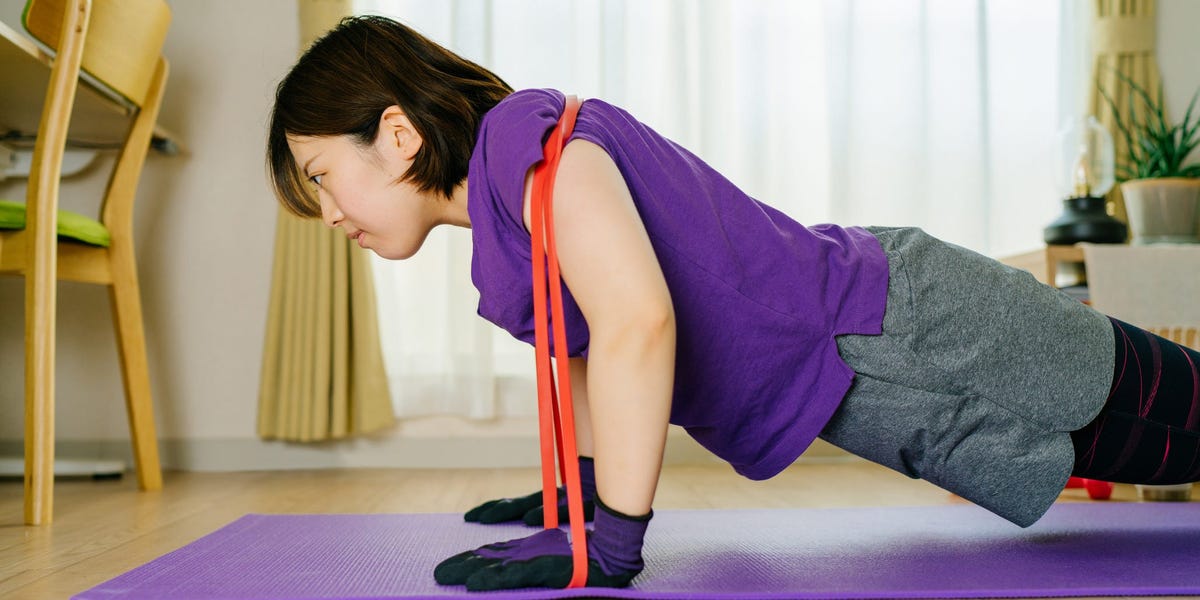- Complex, fad exercises can promise quick results, but trainers say they aren’t necessary for gains.
- Modifying exercise can be helpful if it works better for your body or keeps you motivated.
- But you can make good progress by doing simple exercises to gradually build muscle and strength.
Stay away from resistance bands – Social media is full of flashy workouts loaded with jumps, bands or other complicated add-ons, but they’re not always the best way to get in shape, according to personal trainers.
You can modify an exercise to work better for your body and your goals, or even make it more effective. But adding a series of adjectives to increase intensity can also waste your energy, increase injury risk and make it harder to progress, two coaches told Insider.
Here’s how to know when to change up a move for best results and when to stick to the basics.
You can and should modify exercise to make it work better for your body.
Making small adjustments to help you complete an exercise with good form can make it more effective, Miriam FriedNew York-based personal trainer and founder of strong MFInsider said.
Sometimes called “scaling,” certain changes help tailor exercise to your unique physiology, ability, and even how you feel that day. While scaling is a great option for beginners, it’s not just based on fitness experience and is a useful tool for everyone, according to Fried.
“The edits are great and shouldn’t be seen as something negative,” she said.
Here are some examples :
- Eccentric (or Negative) Representatives: By isolating the lengthening or lowering part of a movement, eccentrics can help build muscle and strength, and help you perform more reps of difficult exercises like pull-ups.
- Incline/Declination: Changing the angle of a movement to increase or decrease the difficulty – an example is putting your hands on a box or bench for an incline push-up.
- Partial elevation: Used to change the angle of a joint (and your body’s range of motion), such as putting a protective plate under your heels during a squat can help you deepen the movement.
According to Ben Foster, founder and head coach of the People’s athletics club.
“Exercise is so individualized that I encourage people to play around with different variations to see what works best for their body,” he told Insider.
More intense versions of exercise can increase gains, but sometimes backfire
Certain types of exercise modifiers are designed to make movements more difficult, which can help experienced athletes continue to progress once they’ve mastered the basics, according to Foster.
“The more modifiers I see someone perform, the more advanced I would expect someone to be,” he said.
Examples include:
- Deficit: Elevate your body or workout equipment to create a greater range of motion, such as putting your hands on dumbbells to do push-ups so your chest goes further before it hits the floor.
- Strip: Added a resistance band to increase the tension on a movement (or cue muscle engagement).
- Plio: Added an explosive component like a jump to an exercise.
- Instability (or “chaos”): Added a balance element to a move, such as crouching on a Bosu ball.
- Combinations: Sequence of exercises in an uninterrupted sequence, such as a lunge with a bicep curl.
However, difficult variations can sometimes be a distraction from slow, steady progress, which usually involves a gradual increase in intensity, such as weight or reps, over time, a principle known as overload. progressive.
“If you’re constantly changing the way you perform an exercise, you’re not able to measure your improvement,” Foster said.
Making a movement more complex can also increase the risk of injury if you’re not careful when subjecting your body to unfamiliar stress, he added.
You don’t need complicated exercises to build muscle and strength
Despite what influencers may tell you, an exercise doesn’t have to be a full sentence to be effective. Simple exercises can help you build strength and muscle, and beginners can progress quickly in the gym with just basic moves like squats, deadlifts, push-ups and pull-ups, the trainers said.
“Somebody who’s new is going to get a lot out of regular exercise,” Foster said.
Fried compared exercise supplements to nutritional supplements — helpful in some cases but not necessary, and not a substitute for a solid foundation of healthy habits.
“We want to accelerate progress and people are looking for the secret to doing that, but there’s no secret. It’s just consistency and repetition,” she said. “You could stick to the basic exercises for the rest of your life and you’ll keep improving.”
Mixing it up in the gym can keep you motivated, but don’t sacrifice good form
One of the benefits of adding new exercise variations is that it can be fun to try new things, which makes you more likely to want to work out. For best results, start a new movement gradually to allow your body to adapt and don’t lose sight of the basics, according to Foster.
“We want people to master the basics, but that’s easy to say as people who care about fitness,” he said. “If these exercises eventually get people into the gym, it’s a pretty low risk. I won’t lose any sleep over it.”
WATCH NOW: Popular Videos from Insider Inc.
Loading…
